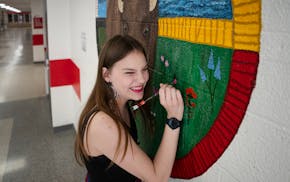A food waste recycling program that uses robots, artificial intelligence and green composting bags will allow residents of Washington and Ramsey counties to throw their table scraps out with their regular garbage. Just not right away.
The massive undertaking is being phased in across the two counties, but by 2026 should divert about 30,000 tons of food waste annually to make compost or even renewable energy, said Ramsey County Commissioner Victoria Reinhardt.
"There's a lot of energy in what we throw out," she said.
A staged rollout of the free program will see some 40,000 households in Maplewood, Newport, Cottage Grove and North St. Paul join this fall. It's not yet known which communities will get the service next but residents can sign up for notices at foodscrapspickup.com.
The counties have run a pilot program since April with 2,200 houses, mostly to test the sorting equipment that relies on artificial intelligence to spot the compost bags mixed in with the rest of the garbage. The food scrap recycling plan doesn't require residents to use a separate garbage can for their compost, but instead asks people to put their food scraps including meat and dairy into a provided green compost bag before tossing it into the trash.
Since 2016, all waste produced by 800,000 people and 70,000 businesses in Washington and Ramsey counties has been trucked to a shared site, the Recycling and Energy Center in Newport, for processing. Inside a new 24,000-square-foot food scrap recycling building added to the center this spring, the compost bags will be taken out of the waste stream by one of four robotic arms guided by scanners searching the trash as it passes by on conveyor belts, said manager Sam Holl.
Each robotic arm is capable of 25 to 30 "picks" per minute, but like all new employees, the robots still are learning how to do the job, he said.
The arms sometimes pull items other than compost from the waste stream, like a gray bag rather than the green ones used for compost. As the system is tested each week, the robots' so-called "neural network" improves and makes fewer mistakes. A similar system using robotic arms was added to the recycling center in 2020 to pick out aluminum, Holl said.
After the food scraps are sorted, they will be sent to an organics recycling site run by the Mdewakanton Sioux community for repurposing as compost. A longer-term plan calls for sending the food scraps to an anaerobic digester that will convert the waste into gas energy; that facility has not yet been built.
The food scraps collection program will be free for residents. The county plans to distribute the green composting bags to eligible households.
The county's goal is for 40% of eligible households to take part in the program, or about 127,000 houses. The county's food recycling program will help Ramsey and Washington counties take a big step toward the state's goal of recycling 75% of waste by 2040.
As sustainability becomes more common and a larger part of what's taught to children, it's become important for the county to "demonstrate our beliefs," said Washington County Commissioner Fran Miron.
He said when he talks to the public about the food scrap recycling program, the first question he often hears is, "When can I have it?"

'No Mow May' eases to 'Less Mow May' in some Twin Cities suburbs

Centennial High School senior highlights Native American community in new mural
Remade Stillwater riverfront could bring new parks, boat launch, picnic space and fishing piers
Minnesotan's path from ISIS front lines to asset in war on extremism will be on display at sentencing

